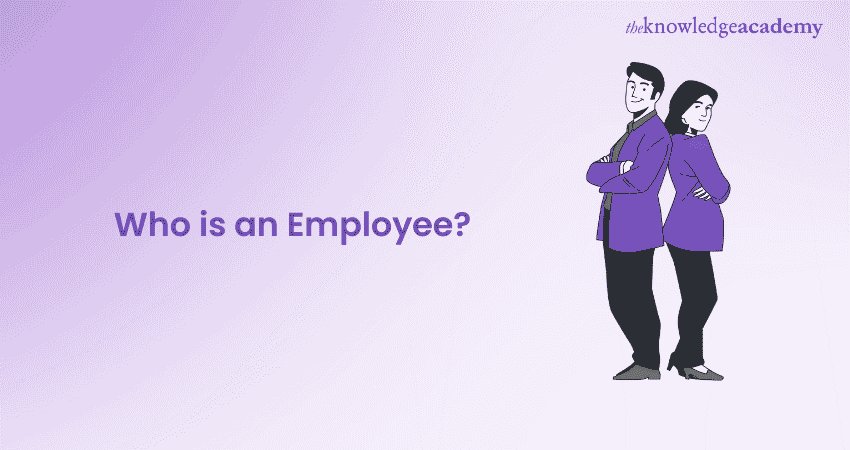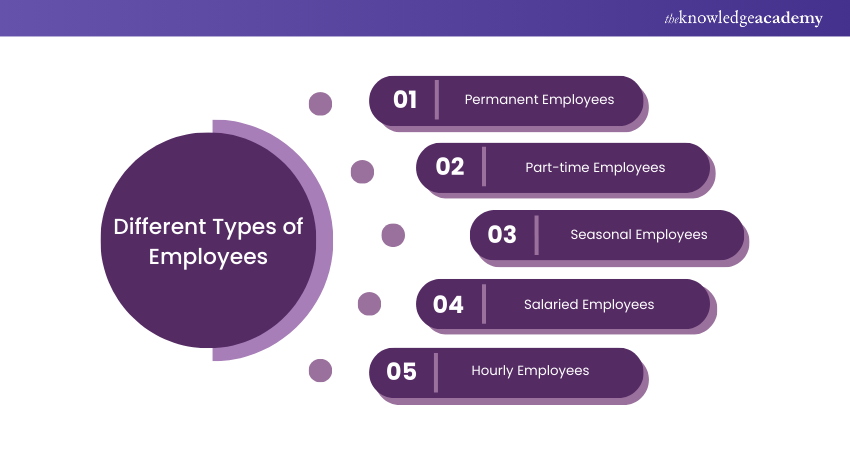We may not have the course you’re looking for. If you enquire or give us a call on 800600725 and speak to our training experts, we may still be able to help with your training requirements.
We ensure quality, budget-alignment, and timely delivery by our expert instructors.

Imagine your business as a thriving ecosystem, where each role contributes to the overall health and growth of the organisation. At the heart of this ecosystem are your Employees. But Who is an Employee and what do they do?
Understanding Who is an Employee is not just a matter of legal compliance; it’s about recognising the value each person brings to your team. Employees are the lifeblood of corporations and institutions, their labour and creativity driving the engines of progress and innovation. They are the individuals who bring ideas to life, execute strategies, and drive success. Let’s dive in to learn more!
Table of Contents
1) Who is an Employee?
2) What Does an Employee do?
3) Different Types of Employees
4) Tips for Hiring Employees
5) Conclusion
Who is an Employee?
An employee is someone hired by a person or company to perform services. Business owners pay employees to help grow and maintain the business. Employees usually have a set pay rate and an employment contract, either written or implied. However, some workers are not legally classified as employees and fall under a different tax classification. The IRS uses three main criteria to determine employee status:
a) Control of Finances: If you manage the financial aspects of a person's job, such as their payment schedule and method, they might be an employee.
b) Control of Behaviour: Employees follow specific policies, work schedules, locations, and use designated supplies and equipment. Training workers can also indicate an employment relationship.
c) Business Relationship: The nature of your business relationship with a worker affects their classification. Contracts and benefits suggest an employee-employer relationship. Hiring someone for an essential, ongoing role typically means they are an employee.
What Does an Employee do?
The Employee's functions differ from one field of activity to another, as do their respective jobs. Nevertheless, workers often have to do their work when it is assigned to them by the employer. On the other hand, they might be expected to attend meetings, team up with other workers, and hold discussions with clients or customers.
For example: A worker in a shop may perform such tasks as stocking shelves, helping customers, and operating a cash register. A worker in an office may be involved in answering phones, replying to emails, or filing documents. An Employee in a factory may be engaged in tasks like operating a machine, assembly products or performing quality checks.
Different Types of Employees
Different types of Employees are classified based on their employment status. Let’s take a look at them below:

1) Permanent Employees
Permanent Employees are hired for an indefinite period of time and are entitled to all the benefits and protections that come with being an Employee. Let's explore some of the benefits:
1) Health insurance
2) Paid time off/vacations
3) Retirement benefits
Typically, Employees are expected to work full-time and are compensated with a monthly or hourly wage. Permanent staff members are essential to any organisation, providing stability and ongoing operations. Additionally, they are afforded opportunities for career development and professional advancement.
2) Part-time Employees
The difference between full-time and part-time Employees is that part-time Employees work fewer hours than full-time Employees, and are not entitled to the same benefits as full-time Employees. Nevertheless, they might be qualified for some benefits which include health insurance. They mainly get an hourly pay, and their working schedule is flexible.
Part-time Employees tend to be students, retirees, or people who value a balance between work and private life. They are an affordable backup workforce for businesses with limited budgets but need someone else.
3) Seasonal or Temporary Employees
Seasonal or temporary Employees are hired for the duration of a particular period, such as, the holiday season or a one-off project. They frequently tend to be deprived of the right to the same privileges as permanent staff. They are mostly paid on an hourly basis and have a flexible time schedule.
Sometimes, retailers with a seasonal product demand hire Seasonal workers to ensure higher production or sales during a particular period of the year. They are an efficient way of dealing with the extra volume of work during the peak seasons.
4) Salaried (Exempt)
Employees on Salary are paid a fixed amount for the specified number of working hours. They are not entitled to overtime wages or other wage and hour laws. They are usually expected to work full-time hours.
Salaried Employees are often professionals with managerial or executive positions within an organisation. They are responsible for making important decisions that affect the business.
Hourly (Non-exempt)
Hourly Workers are generally paid hourly wages for the hours they work. They are entitled to overtime payment and other pay-by-hour protections. They might work full-time or part-time, depending on their requirement level.
Hourly Employees usually hold an entry-level position where they undertake either manual duties or office work in the organisation. They are an integral aspect of any company, completing daily tasks to make the organisation's function better and smoother.
Master HR skills to boost your career with our Certified HR Advisor Course today!
Tips for Hiring Employees
Recruiting staff is a crucial part of growing a small company. Here are a few crucial suggestions to make the process more efficient:
a) Understand Local Regulations: Get to know state and local labour regulations. This information will make your duties clearer and assist you in choosing between hiring full-time or part-time staff.
b) Plan Their Roles: Compile a list of all responsibilities you plan to delegate to new Employees and calculate the amount of time needed for each task. This planning aids in figuring out the required staff numbers and helps create specific job descriptions.
c) Organise Hiring Documents: Make sure you have all required forms prepared, including tax documents and any other work-related paperwork. Getting these ready ahead of time can help streamline the job offer extension process.
d) Consider Insurance Needs: Although not required universally, getting workers' compensation and disability insurance can safeguard your business from responsibility and ensure the well-being of your Employees.
e) Offer Attractive Benefits: Basic perks like paid time off or flexible schedules can attract top candidates to your job openings.
f) Develop HR Policies: Despite having a small team, it is advisable to set up defined HR policies. These policies must address topics such as wrongdoing, absence due to illness, Absence Management, and other work-related matters to maintain a properly governed work atmosphere.
Utilising these tactics can enhance your recruitment process, helping you attract the right candidates. This ensures you hire and retain individuals who contribute to your company’s growth.
Upgrade your legal knowledge with our Employment Law Training – Register now!
Conclusion
We hope you read and understand Who is an Employee. Employees are an essential part of any organisation. Understanding the different types of Employees can help you make well-versed decisions about your business or career. Additionally, being familiar with Employee Relations Interview Questions can provide valuable insights for HR professionals and job seekers alike.
Build Stronger Teams with Our Employee Relations Training - Sign up today!
Frequently Asked Questions
Who is the Employee and Employer?

An employee is a person hired under a contract to perform specific tasks in exchange for wages or salary. An employer is an organisation or individual that hires employees, provides work, and compensates them. The relationship is based on mutual agreements, rights, and responsibilities outlined in employment terms.
What is an Example of an Employee?

An example of an employee is a teacher working at a school under a contract, teaching students and following the school’s guidelines. The school, as the employer, provides the teacher with a salary, benefits, and a work environment in exchange for their expertise and time.
What are the Other Resources and Offers Provided by The Knowledge Academy?

The Knowledge Academy takes global learning to new heights, offering over 3,000 online courses across 490+ locations in 190+ countries. This expansive reach ensures accessibility and convenience for learners worldwide.
Alongside our diverse Online Course Catalogue, encompassing 19 major categories, we go the extra mile by providing a plethora of free educational Online Resources like News updates, Blogs, videos, webinars, and interview questions. Tailoring learning experiences further, professionals can maximise value with customisable Course Bundles of TKA.
What is The Knowledge Pass, and How Does it Work?

The Knowledge Academy’s Knowledge Pass, a prepaid voucher, adds another layer of flexibility, allowing course bookings over a 12-month period. Join us on a journey where education knows no bounds.
What are the Related Courses and Blogs Provided by The Knowledge Academy?

The Knowledge Academy offers various HR Leadership Courses, including the HR Skills For Non-HR Managers, HR Management Course, and Human Resource Budgeting Training. These courses cater to different skill levels, providing comprehensive insights into HR.
Our HR Resources Blogs cover a range of topics related to Human Resources, offering valuable resources, best practices, and industry insights. Whether you are a beginner or looking to advance your HR skills, The Knowledge Academy's diverse courses and informative blogs have got you covered.
Upcoming HR Resources – Learn about Human Resources Batches & Dates
Date
 Employee Engagement Training
Employee Engagement Training
Fri 28th Mar 2025
Fri 23rd May 2025
Fri 25th Jul 2025
Fri 26th Sep 2025
Fri 28th Nov 2025






 Top Rated Course
Top Rated Course



 If you wish to make any changes to your course, please
If you wish to make any changes to your course, please


